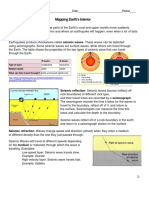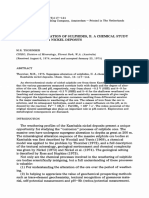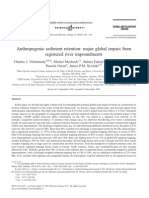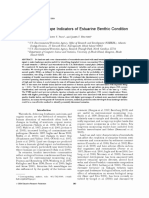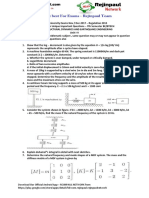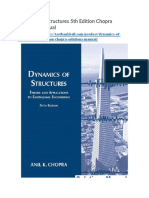Letters JV-CIEH #1
Letters JV-CIEH #1
Uploaded by
JamesVerdonCopyright:
Available Formats
Letters JV-CIEH #1
Letters JV-CIEH #1
Uploaded by
JamesVerdonCopyright
Available Formats
Share this document
Did you find this document useful?
Is this content inappropriate?
Copyright:
Available Formats
Letters JV-CIEH #1
Letters JV-CIEH #1
Uploaded by
JamesVerdonCopyright:
Available Formats
School of Earth Sciences,
University of Bristol,
Wills Memorial Building,
Queens Road,
Bristol, BS8 1R
ames!"erdon#$ristol!ac!u%
&'()*(&)1+
,o the $oard of the -hartered .nstitute for Environmental /ealth,
. am 0riting in res1onse to your recent re1ort, 2Shale 3as and 4rac%ing5
E6amining the Evidence7 1u$lished in tandem 0ith Scientists for 3lo$al
Res1onsi$ility 8S3R9! ,his re1ort claims to 1rovide an 2im1artial7 and 2evidence:
$ased7 revie0 of the issues surrounding shale gas e6traction in the U;! ,he
authorshi1 $y 1rofessional $odies lends 0eight to this 2evidence:$ased7
im1ression! /o0ever, $y any standard of scholarshi1 this re1ort falls 0ell short!
4actual errors, cherry 1ic%ing of scienti<ic literature, omissions of %ey facts and
scienti<ic 1a1ers a$ound throughout the re1ort! ,he 1ur1ose of this letter is to
dra0 your attention to these errors, and to raise my concerns a$out the
im1lications of -.E/s endorsement of this re1ort!
. 0ill $egin $y addressing some of the ma=or issues found in the re1ort! . 0ill do
so in a manner analogous to that 0ith 0hich . am most familiar, namely that of
scholarly 1eer:revie0!
Authorship
. note in 1assing that the lead author of the re1ort recently stood for election for
the 3reen >arty! 3iven that 3reen >arty has cam1aigned vigourously against
shale gas develo1ment in the U;, . feel that this re1resents a con<lict of interest!
Moreover, =udging $y her o0n comments on t0itter, the lead author a11ears to
have =oined 1rotest marches against shale develo1ment at Barton Moss! ?f
course, 1ersonally:held vie0s do not necessarily 1reclude a 1rofessional author
from 1enning an im1artial re1ort on a su$=ect on 0hich they are 0holly 1artial,
or indeed have a con<lict of interest! /o0ever, given the issues raised $elo0, one
is left 0ith the feeling that the S3R(-.E/s stated aim of 1roducing an im1artial,
evidence:$ased re1ort 0as doomed from the $eginning $ased on the choice of
lead authorshi1!
1. Introduction
S3R(-.E/ ma%e the follo0ing claim to differentiate shale and conventional gas
e6traction5 2Unli%e in conventional 0ells, frac%ing in shale re@uires horiAontal
drilling BandC huge num$ers of 0ells7! ,he im1lication is that conventional
hydrocar$on recovery re@uires neither! .n 1oint of fact, lateral 0ell drilling is
no0 common1lace in conventional reservoirs! .ndeed, the techni@ue 0as
1ioneered in the U!;! in the Wytch 4arm 4ield in the early 1DD)s! E@ually, tight
clustering of 0ells is common in onshore conventional <ields, es1ecially those of
an older vintage! E:s1ot drilling 1atterns on a 1), &) or +) acre s1acing is
common in Forth Gmerican conventional reservoirs, and is easily as dense as the
num$er of 0ells used to e6tract shale!
2.1. Seismicity
S3R(-.E/ ma%e the unsu$stantiated assertion that U; geology is su$stantially
more faulted than that of Forth Gmerica! .n reality, the geology across multi1le
shale 1lays across the Forth Gmerican continent is highly varia$le! Some shale
1lays are indeed relatively undistur$ed! /o0ever, others are not! Moreover, even
1lays that a11ear <lat can contain su$stantial faulting! Microseismic data reveals
1otential faults structures in a11ro6imately ')H of datasets recovered in the
USG I faults are far from rare! /o0ever, only a small su$set of faults I those near
to their critical failure stress I might $e re:activated if they are im1inged u1on
$y a hydraulic fracturing o1eration!
,he S3R(-.E/ comments on -uadrillas >reese /all 0ell im1ly that the induced
seismic activity may have im1inged on 0ell$ore integrity! ,he reality is that
casing deformation 0as limited to the lo0er 1art of the 1roduction casing string
I the 1art of the 0ell$ore in 0hich holes have already $een 1unched to allo0 gas
to <lo0! .t is irrelevant to tal% of 0ell integrity in a 1art of the 0ell casing that is
intentionally left o1en to 1roduce gas! Shallo0 ground0ater sources are
1rotected $y different, shallo0er casing strings! ,here has $een no suggestion
that these strings 0ere damaged $y seismicity, nor that 0ell$ore integrity has
$een com1romised!
More generally, the >reese /all seismic events, at magnitude &!' and 1!E, are
relatively small, even $y U; standards! ,he U; e61eriences over E) such events
each year, and ty1ically e61eriences one magnitude + earth@ua%e every 1!E
years, 0hich is almost 1,))) times larger than the >reese /all events! .n
addressing 0hether seismicity 1oses a ris% to 0ell$ore integrity, the authors
might have $een $etter e6ercised $y considering 0hether these regular
occurrences have 1osed 0ell$ore integrity issues for the &,))) onshore, and over
1),))) offshore, 0ells that have drilled in the U;!
2.2. Water and ground contamination
S3R(-.E/ cherry:1ic% the study $y ac%son et al! 8&)1'9 in their discussion of
ground0ater contamination! Such cherry:1ic%ing gives the misleading
im1ression that this is the only study 1erformed in the region, 0hen it is in fact
only one of many! Moreover, S3R(-.E/ neglect to discuss the myriad issues
raised over this 1a1er, for e6am1le the limited num$er of 0ater 0ells sam1led
81+)9, the non:randomness of the sam1ling 1rocess, and the lac% of a $aseline for
com1arison! ,here have in fact $een numerous studies of ground0ater in the
>ennsylvania region and further a<ield! 4or e6am1le5
Molofs%y et al! 8&)1'9, 0ho studied over 1,*)) 0ells in >ennslyvania,
0ith some that included $aseline conditions, and found no correlation
$et0een methane and shale gas 0ells 8and found correlation instead 0ith
to1ogra1hy, im1lying a natural methane source9!
G study of &') 0ater 0ells made $y the -entre for Rural >ennslyvania,
0hich found no im1acts from shale drilling!
G $aseline study made $y the US3S in undrilled 1arts of Sullivan -ounty,
>G, 0hich recorded similar levels of naturally occurring methane to those
found $y ac%son et al! 8&)1'9!
G second $aseline study made $y the US3S across the >ennsylvania:Fe0
Jor% $order, 0hich again recorded similar levels of naturally occurring
methane to those found $y ac%son et al! 8&)1'9!
,he study 1erformed $y Warner et al! 8&)1'9 : the same Ku%e University
team as ac%son et al! 8&)1'9 I over the 4ayetteville shale, Gr%ansas,
0hich found no im1act from drilling!
,he fact that all of these studies have $een neglected re1resents a serious
omission from the re1ort!
Similarly, the failure $y S3R(-.E/ to e6amine in any detail the ra0 statistics of
>G KE> infringements leads them to ma%e misleading statements regarding 0ell
integrity! -onsidine et al! 8&)1&9 did so, and found that of over ',E)) shale gas
0ells drilled in >ennsylvania, only & had caused stray gas migration into shallo0
ground0ater, 0hich re1resents a failure rate of )!)LH! .n $oth cases, re1airs
0ere made to the offending 0ell, and 0ater @uality remediated! ,hese <indings
mirror those made $y the 3round0ater >rotection -ouncil 8&)119, 0ho studied
tens of thousands of 0ells in ?hio and ,e6as, <inding 0ell failure rates of less
than )!1H!
2.3. Water use and waste water
.n their discussion of 0ater consum1tion, S3R(-.E/ ma%e the claim that 20ells
are generally frac%ed several times over their lifetime7! ,his is erroneous! Glmost
all shale 0ells are only ever frac%ed once!
With res1ect to 0ater consum1tion, the reader 0ould surely $e $etter informed
if the authors 0ere to consider 0ater consum1tion over the full life:cycle of shale
gas e6traction, and in com1arison 0ith other forms of energy generation! Such
studies e6ist in the literature, $ut have $een neglected $y S3R(-.E/! 4or
e6am1le, -lar% et al! 8&)1'9 <ind that shale gas use in the 1o0er sector
re1resents only an incremental increase in 0ater consum1tion com1ared to
conventional gas! Similarly, Scanlon et al! 8&)1'9 found that shale gas consumed
su$stantially less 0ater than coal in electricity generation, and that the s0itch
from coal to shale gas 1layed an im1ortant role in ada1ting to recent droughts in
,e6as! ,he memorandum of understanding signed $et0een Water U; and the U;
?nshore ?1erators 3rou1 8U;??39 is also surely of signi<icance to this
discussion!
With res1ect to the F?RM content of <lo0$ac% 0ater, S3R(-.E/ neglect recent
0or% $y Glmond et al! 8&)1+9, 0ho e6amined this issue in detail, and found that
2in no scenario 0as the 1H e6ceedence e61osure greater than 1mSv I the
allo0a$le annual e61osure allo0ed for in the U;7, and that 2the radioactive <lu6
of 1er energy 1roduced 0as lo0er for shale gas than for conventional oil and gas
1roduction, nuclear 1o0er 1roduction and electricity generated through $urning
coal!7
2.4. Local air quality
.n the section on air @uality, S3R(-.E/ 1resent no data 1ertaining to air @uality
during shale develo1ment, and are only a$le to ma%e unsu$stantiated assertions!
/o0ever, such data is availa$le5 for e6am1le Bunch et al! 8&)1+9 e6amined
e6tensive air @uality measurements made over the Barnett Shale, and did not
<ind levels of air 1ollution that 0ould cause concern! Similar surveys in
>ennsylvania made $y the >G KE> 8&)1)9 Mdid not identify concentrations of any
com1ound that 0ould li%ely trigger air:related health issues associated 0ith
Marcellus Shale drilling activitiesM, and overall emissions inventories sho0 a
reduction in air 1ollution as 1o0er generation has s0itched from coal to shale
gas 8>G KE> air emissions inventory, &)119! 3iven that such data is availa$le, .
<ind it disa11ointing that S3R(-.E/ did not ma%e use of it!
3. Climate change
,he most nota$le omission in this section is the <indings of the .>-- made in the
recent 4ifth Gssessment Re1ort! .n this re1ort, the .>-- state that 2in mitigation
scenarios reaching a$out +E) 11m -?
&
e@ concentrations $y &1)), natural gas
1o0er generation 0ithout --S acts as a $ridge technology, 0ith de1loyment
increasing $efore 1ea%ing and falling to $elo0 current levels $y &)E) and
declining further in the second half of the century7! ,he .>-- have made it clear
that they see natural gas e6tracted from shale as a %ey com1onent of greenhouse
gas mitigation strategies from no0 until &)E)!
.n their assessment of the im1act of shale develo1ment on rene0a$le
investment, S3R(-.E/ neglect the 1otential 1ositive im1acts of a$undant natural
gas on de1loyment of rene0a$les! G re1ort $y the Brattle 3rou1 8&)1'9 found a
strong com1lementary relationshi1 $et0een rene0a$les and natural gas,
$ecause the <le6i$ility of natural gas 1rovided $ac%u1 to intermittent rene0a$les
in a 0ay that coal and nuclear 1o0er cannot! ,his relationshi1 is evidenced $y
the fact that ,e6as, a leading state in terms of shale gas develo1ment, is also
leading the 0ay 0ith res1ect to rene0a$le, and es1ecially 0ind, energy!
4. Socioeconmic issues
While the im1act of shale develo1ment on gas 1rices is dis1uted, S3R(-.E/
neglect a %ey as1ect of the 1otential economic im1act, 0hich is the im1act on the
0ider economy, and to the e6che@uer! .t is e61ected that the need to im1ort gas
0ill cost the U; economy over N1E $illion 1!a!! ,his is money lost to the U;
economy, 1aying no ta6 and creating no =o$s! Komestic shale develo1ment
ensures that this revenue stream remains in the U;!
S3R(-.E/ com1are =o$s created in $oth shale and rene0a$le energy industries!
,his is a false com1arison I there is no reason 0hy 0e cannot encourage
investment in $oth of these industries!
S3R(-.E/ claim that shale develo1ment 0ill have a negative im1act on tourism,
$ut 1rovide no evidence to $ac% u1 this claim! .n fact, a recent study $y ?6ford
Economics 8&)1'9 has sho0n that, the &))D recession aside, tourism in
>ennsylvania has increased su$stantially in recent years, a the same time as the
Marcellus shale has $een under develo1ment!
!. Can we manage without shale gas"
.n this section, S3R(-.E/ neglect the many different uses 0e have for natural
gas! S1eci<ically, they focus on the use of natural gas in electricity generation,
0hich accounts for only a$out 1('
rd
of our consum1tion, the rest $eing used in
domestic heating and coo%ing, and in industrial 1rocesses! S3R(-.E/ ma%e no
attem1t to e6amine ho0 0e might 2manage 0ithout shale gas7 in these sectors,
0hich leaves a ga1ing hole in their analysis!
Even in their discussion of the electricity sector, S3R(-.E/ focus solely on the
1rice com1arison $et0een fossil fuels and rene0a$les! ,he fact that rene0a$les
are $ecoming chea1er is to $e 0elcomed! /o0ever, the decreasing cost of
rene0a$les has little $earing on 0hether rene0a$les alone 0ill $e a$le to meet
the needs of the U; consumer, $oth in terms of overall demand, and in meeting
that demand as and 0hen the consumer re@uires it 8i!e! 0ithout intermittency9!
,his @uestion, rather than 1rice alone, is the 1ertinent one 0ith regards the issue
of 0hether or not 0e need shale 8or any other9 gas! S3R(-.E/ ma%e no attem1t
to ans0er this, leaving a second ga1ing hole in their analysis!
4ortunately, the Fational 3rid have 1rovided a num$er of future energy
scenarios, 0hile 4riends of the Earth have also made an admira$le attem1t to
outlining their ideal future energy scenario! Whether one considers the Fational
3rids 23one 3reen7 scenario, or 4riends of the Earths 2-lean British Energy7
scenario, it is clear that even under the most o1timal assum1tions there is a
su$stantial need for natural gas in the U;s energy sector, and that this need 0ill
e6ist for some time to come, regardless of 0hether 0e choose to develo1 shale
gas! S3R(-.E/ claim a lac% of s1ace to go into detail com1aring rene0a$les and
shale gas! /o0ever, 0hen this 0or% has already $een done, in great detail, $y the
Fational 3rid, it seems very strange indeed that S3R(-.E/ 0ould 0ant to
com1letely neglect their <indings!
4inally, S3R(-.E/ note that in nations 0here e6tensive hydro1o0er is availa$le,
certain nations are a$le to $ecome suf<icient in rene0a$le energy! ,his is all 0ell
and good, $ut has no $earing on the situation in the U;, 0here 0e do not have
ca1acity for su$stantial hydro1o0er, and is therefore irrelevant 0ith res1ect to
the issue of 0hether or not 0e need shale gas in the U;!
#o conclude$
. 0ill couch my conclusions in the s1irit in 0hich this letter has $een 0ritten,
namely that of 1roviding 1eer revie0! 3iven the e6tent of factual errors, cherry:
1ic%ing, failure to consider relevant literature, logical fallacies and statements
unsu11orted $y evidenceO 0ere this re1ort su$=ected to the %ind of ro$ust 1eer
revie0 on 0hich modern science is $ased, then . do not $elieve it 0ould ma%e it
through to 1u$lication! ,o 1ut things more $luntly, the re1ort re1resents a
shoc%ing lac% of scholarshi1, and falls 0ell short of the standards one 0ould
e61ect from a 1rofessional society!
My concerns have their 1rinci1al $asis in the accurate 1ortrayal of a delicate and
sensitive to1ic! /o0ever, . feel . should also 1oint out the im1act of the -.E/s
endorsement of this re1ort, $oth on the institution as a 0hole and on the ran%:
and:<ile mem$ershi1!
,he -.E/ >rofessional -ode of -onduct 1laces great im1ortance u1on
maintaining the standing and credi$ility of the organisation 81aragra1hs &!& and
&!'9! More s1eci<ically, 1aragra1h +!E states that mem$ers should 2ta%e all
reasona$le ste1s to ensure that information 1rovided $y them in a 1rofessional
ca1acity on a matter 0ithin their %no0ledge or com1etence is accurate and
com1lete!7 .t is clear that this re1ort achieves neither accuracy nor com1leteness!
>resuma$ly, the -.E/ as an institution 0ishes to add its voice to the de$ate over
U; shale develo1ment, and more s1eci<ically to have an in<luence on 1olicy:
ma%ers and regulators! /o0ever, $y attaching their name and ma%ing claims of
im1artiality to a re1ort that is neither im1artial nor reaches the standard of
scholarshi1 e61ected of a 1rofessional $ody, the -.E/ ris%s of ma%ing itself
a11ear less than com1etent and less than im1artial in the eyes of sta%eholders at
the heart of the U; shale discussion! Gs such, the more li%ely outcome is that the
vie0s of the -.E/ are seen as $oth 1artisan and ill:informed, and therefore to $e
dismissed, 0ith the net result that the -.E/ is marginalised from the de$ate,
rather than more dee1ly involved!
. also have concerns on the im1lications of this re1ort for the ran%:and:<ile
mem$ershi1 of -.E/, on 0hom this re1ort re<lects e6tremely $adly! Fote, for
e6am1le, that the lac% of scholarshi1 sho0n in this re1ort has already $ecome
the su$=ect of ridicule on social media! . myself do not regularly interact 0ith
-.E/ mem$ers 8at least, not to my %no0ledge9! /o0ever, it 0ould not $e
sur1rising if some of your mem$ershi1 0ere 0or%ing in sectors that are, or are
li%ely to, interact 0ith the nascent U; shale gas industry! 4or e6am1le, in many
cases o1erators are loo%ing to develo1 relationshi1s 0ith inde1endent
environmental consultants in order to ensure their foot1rint is minimised!
/o0ever, for those 0hose <irst interaction 0ith the -.E/ is this re1ort, it might
$e a natural assum1tion 8erroneously, . ho1e9 that the lac% of 1rofessionalism
sho0n in this 1articular re1ort is re1resentative of -.E/ mem$ers more
generally! ?ne 0onders 0hether this might $ecome a source of em$arrassment,
or indeed the cause of lost o11ortunities and marginalisation, for -.E/ mem$ers
0ho might other0ise have a role to 1lay in advisory and(or regulatory roles!
3iven the a$ove failings, . 0ould a11reciate a res1onse from the -.E/ that
outlines and =usti<ies the decision:ma%ing 1rocess that lead to the -.E/ attaching
their name to this re1ort! .n 1articular, if the stated aim 0as to 1roduce an
im1artial, evidence:$ased re1ort, 0hy the -.E/ felt it a11ro1riate to a11oint as
lead author an election candidate for a 1olitical 1arty that has stated is
o11osition to the industry in the star%est terms, and 0ho has documented
1u$licly her involvement in 1rotests outside of drilling sitesP
. 0ould also $e interested to %no0 0hether the document 0as su$=ect to any
%ind of revie0 1rocess $y the -.E/ 8e6ternal or internal9 1rior to 1u$licationP ?f
course, once 1u$lished there is no going $ac%, $ut . 0ould also a11reciate your
res1onse and comments on the issues to 0hich . have dra0n attention a$ove!
Jours sincerely,
Kr! ames "erdon, >h!K!, M!Sci, MG8-anta$9,
FER- Research 4ello0,
School of Earth Sciences,
University or Bristol!
You might also like
- 1959 - SEAOC Bluebook Seismic Design Recommendations - J Diebold, K.mooreDocument9 pages1959 - SEAOC Bluebook Seismic Design Recommendations - J Diebold, K.mooreRichard Gutierrez ChoqueNo ratings yet
- Creation's Tiny MysteryDocument382 pagesCreation's Tiny MysteryRudi YapNo ratings yet
- RSPMatch2005 Manual V1Document9 pagesRSPMatch2005 Manual V1unreachable_UKNo ratings yet
- Mapping Earths Interior ExtractDocument4 pagesMapping Earths Interior ExtractJoanna CerreliNo ratings yet
- Isotopic Variations in Meteoric Waters-Craig 1961Document3 pagesIsotopic Variations in Meteoric Waters-Craig 19611unchboxNo ratings yet
- John Et al.1969.SLICKENSIDES IN RESIDUAL SOILS AND THEIR ENGINEERING SIGNIFICANCEDocument8 pagesJohn Et al.1969.SLICKENSIDES IN RESIDUAL SOILS AND THEIR ENGINEERING SIGNIFICANCEjose monteNo ratings yet
- ChernobylDocument5 pagesChernobylvivekvpsfeNo ratings yet
- TOC From Well LogsDocument23 pagesTOC From Well Logslilim020776No ratings yet
- Notes-Documentary-Aerosol Crimes 2005Document8 pagesNotes-Documentary-Aerosol Crimes 2005Tara AlvaradoNo ratings yet
- Variation of 18O Content of Water From Natural SourcesDocument12 pagesVariation of 18O Content of Water From Natural SourcesAndreas AntonakosNo ratings yet
- Chapter 1Document9 pagesChapter 1Sreedhar Reddy SajjalaNo ratings yet
- Pseudokarst Groundwater Hydrologic Characteristics of A Mine Spoil AquiferDocument16 pagesPseudokarst Groundwater Hydrologic Characteristics of A Mine Spoil AquiferCaegeoNo ratings yet
- 1992 Abrams 1992aDocument14 pages1992 Abrams 1992ajohnsmith1982No ratings yet
- The CRUISE of The BETSEY Revised Complete With DatesDocument49 pagesThe CRUISE of The BETSEY Revised Complete With DatesGeoBlogsNo ratings yet
- Climate Change and Ozone Depletion: Thinking GoalsDocument8 pagesClimate Change and Ozone Depletion: Thinking GoalsJgombisNo ratings yet
- Terry Engelder Response To WFAA (June 6, 2014)Document6 pagesTerry Engelder Response To WFAA (June 6, 2014)steve_everleyNo ratings yet
- New Rich Text DocumentDocument8 pagesNew Rich Text DocumentbbtrNo ratings yet
- Silberstein Et Al 1986Document17 pagesSilberstein Et Al 1986tonyNo ratings yet
- Integrity of Oil and Gas WellsDocument2 pagesIntegrity of Oil and Gas WellsAlexander KnightNo ratings yet
- Accenture 1Document29 pagesAccenture 1Punit ChhichhiaNo ratings yet
- Bahan CFCDocument17 pagesBahan CFCMohamad Aswad Mohd SaadNo ratings yet
- Engineering Geology: Where Civilization and Earth MeetDocument27 pagesEngineering Geology: Where Civilization and Earth MeetBishwajit ChowdhuryNo ratings yet
- The Organic Content of The Bone Spring Formation As Evaluated by The Delta Log R Method of Log AnalysisDocument98 pagesThe Organic Content of The Bone Spring Formation As Evaluated by The Delta Log R Method of Log Analysisragingpheonix87100% (1)
- Low Level of Stratospheric Ozone Near The Jharia Coal Field in IndiaDocument10 pagesLow Level of Stratospheric Ozone Near The Jharia Coal Field in Indiasharma1503No ratings yet
- Endapan Mineral (English Language)Document7 pagesEndapan Mineral (English Language)Rio AnggaraNo ratings yet
- Ea Project AwarenessDocument20 pagesEa Project AwarenessRency EapenNo ratings yet
- The University of Chicago Press The Journal of GeologyDocument10 pagesThe University of Chicago Press The Journal of GeologyJampelNo ratings yet
- Gis ProjectDocument18 pagesGis Projectapi-300877005No ratings yet
- Letters JV-CIEH #3Document7 pagesLetters JV-CIEH #3JamesVerdonNo ratings yet
- 15 Roy Abstract WC2009Document1 page15 Roy Abstract WC2009namkay_tenzynNo ratings yet
- Craig, H. 1961Document2 pagesCraig, H. 1961Esperanza SalasNo ratings yet
- Durham Research OnlineDocument16 pagesDurham Research OnlineSasa ZivanovicNo ratings yet
- 2Document22 pages2mahdijokar251374No ratings yet
- Iep Final DraftDocument5 pagesIep Final Draftapi-253822788No ratings yet
- Climate Change EssayDocument12 pagesClimate Change EssayacrimonoctogonNo ratings yet
- Earth MadeDocument5 pagesEarth Madebhevsz009No ratings yet
- OSYM PASSAGES 1 (Oklu AçDocument147 pagesOSYM PASSAGES 1 (Oklu AçSinan EkerNo ratings yet
- Flash Flood BibliographyDocument24 pagesFlash Flood BibliographyMutia Amanda AriefNo ratings yet
- Engineering Geological Characterization of Lahore Soil, Based On Geotechnical Testing and Mineralogical Composition Using X-Ray DiffractionDocument5 pagesEngineering Geological Characterization of Lahore Soil, Based On Geotechnical Testing and Mineralogical Composition Using X-Ray DiffractionDaniyal AhmadNo ratings yet
- Technical Notes.: Determination of Thermal Transport Properties in Ammonium PerchlorateDocument3 pagesTechnical Notes.: Determination of Thermal Transport Properties in Ammonium PerchlorateSharat ChandraNo ratings yet
- Yousuf Ahmed Hamid FudolDocument143 pagesYousuf Ahmed Hamid FudolYOUSUPHANo ratings yet
- APES Chapter 21 Water Pollution NotesDocument9 pagesAPES Chapter 21 Water Pollution NotesAlejandra Resendiz TorresNo ratings yet
- Water Project ProposalDocument4 pagesWater Project ProposalCesar Avila80% (5)
- Thornber1975 PDFDocument28 pagesThornber1975 PDFDevito PradiptaNo ratings yet
- Logan & Brooker. The Macroinvertebrate Faunas of Riffles and PoolsDocument8 pagesLogan & Brooker. The Macroinvertebrate Faunas of Riffles and PoolsGabriel TrujilloNo ratings yet
- An OceanDocument6 pagesAn OceanrexkingdomNo ratings yet
- UntitledDocument42 pagesUntitledAstolfo Gomes de Mello AraujoNo ratings yet
- 1979-Mechanical Behavior of Superplastic Ultrahigh Carbon Steels at Elevated TemperatureDocument11 pages1979-Mechanical Behavior of Superplastic Ultrahigh Carbon Steels at Elevated TemperatureCésar Cristov León OrtegaNo ratings yet
- Petrophysical Evaluation of Haynesville Shale ReservoirDocument24 pagesPetrophysical Evaluation of Haynesville Shale ReservoirMaclean Jacob EneotuNo ratings yet
- GRE ReadingDocument264 pagesGRE ReadingDavid NyamjavNo ratings yet
- Geologia Econômica KupferschieferDocument2 pagesGeologia Econômica KupferschieferDavid QMNo ratings yet
- Patterson 1956Document8 pagesPatterson 1956krishy19No ratings yet
- C) - T) V - Att0Y-A L (Ew Alloy: For TheDocument4 pagesC) - T) V - Att0Y-A L (Ew Alloy: For TheLaurentia PetcuNo ratings yet
- Sedimentology of A Sandstone-Carbonate Transition, Lower San Andres Formation (Middle Permian), Lincoln County, New Mexico: Master's Thesis, University of Wisconsin, Madison, Wisconsin, 156 P.Document177 pagesSedimentology of A Sandstone-Carbonate Transition, Lower San Andres Formation (Middle Permian), Lincoln County, New Mexico: Master's Thesis, University of Wisconsin, Madison, Wisconsin, 156 P.Scott LaingNo ratings yet
- Ocr Dating PaperDocument14 pagesOcr Dating Paperallison33297No ratings yet
- Vörösmarty - Flow AccumulationDocument22 pagesVörösmarty - Flow AccumulationAndreea TiNo ratings yet
- Hamilton SP Geophysics2008Document9 pagesHamilton SP Geophysics2008api-204723334No ratings yet
- Methane Contamination of Drinking Water Accompanying Gas-Well Drilling and Hydraulic FracturingDocument5 pagesMethane Contamination of Drinking Water Accompanying Gas-Well Drilling and Hydraulic Fracturingengrhabib781No ratings yet
- Engineering Geology - Chapter 3 - CompressedDocument39 pagesEngineering Geology - Chapter 3 - CompressedmilaNo ratings yet
- The Effects of Basement Faults On Thermal ConvectiDocument25 pagesThe Effects of Basement Faults On Thermal ConvectiSwiggly PandaNo ratings yet
- Tmp3e7 TMPDocument13 pagesTmp3e7 TMPFrontiersNo ratings yet
- Chapter19 LookBack WayForwardDocument23 pagesChapter19 LookBack WayForwardAnonymous Ci2xHigNo ratings yet
- 2152-0.50LL Esr-Str-Cal-01 - R1Document30 pages2152-0.50LL Esr-Str-Cal-01 - R1sssmitNo ratings yet
- Response of Thin Lightly-Reinforced Concrete Walls Under Cyclic LoadingDocument13 pagesResponse of Thin Lightly-Reinforced Concrete Walls Under Cyclic LoadingJuan BravoNo ratings yet
- Partial Fixity BaseDocument24 pagesPartial Fixity Basekhemindra narain100% (1)
- 1663pub5 PDFDocument6 pages1663pub5 PDFVidal Gonzalez PereiraNo ratings yet
- DRM School SafetyDocument5 pagesDRM School SafetySoumyaRoyChoudhuryNo ratings yet
- Landslide Hazard InformationDocument8 pagesLandslide Hazard Informationgloria tolentino100% (1)
- Seismic Analysis ProcedureDocument24 pagesSeismic Analysis ProcedureAnonymous nwByj9LNo ratings yet
- Pre3 StudentBook Answer (Lingo Learn - Ir)Document27 pagesPre3 StudentBook Answer (Lingo Learn - Ir)ati.s.vafaeiNo ratings yet
- DIASS Script Group 1Document10 pagesDIASS Script Group 1Edrian Dave D. CasamaNo ratings yet
- M. Sc. Thesis Proposal - Abul KhairDocument6 pagesM. Sc. Thesis Proposal - Abul KhairUMME NASRINNo ratings yet
- EQTip 22Document2 pagesEQTip 22raj_ferrariNo ratings yet
- 4 SpheresDocument3 pages4 SpheresJoan PerocheNo ratings yet
- Development of Earthquake Early Warning System Using ADXL335 AccelerometerDocument6 pagesDevelopment of Earthquake Early Warning System Using ADXL335 Accelerometerebank ekalayaNo ratings yet
- Blindsided - Planet X and Earthchanges - Where Will You Be by Mark HazlewoodDocument95 pagesBlindsided - Planet X and Earthchanges - Where Will You Be by Mark Hazlewoodmorefaya2006100% (2)
- Jeff Steven (Order #29356809)Document55 pagesJeff Steven (Order #29356809)Jeff StevenNo ratings yet
- Our Official Android App - REJINPAUL NETWORK FromDocument3 pagesOur Official Android App - REJINPAUL NETWORK FromBerin LarsonNo ratings yet
- Six - Lakh Home From IIT MadrasDocument3 pagesSix - Lakh Home From IIT MadraskalpanaadhiNo ratings yet
- Stability Analysis of Soil Slope Subjected To Blast Induced Vibrations Using FLACDocument11 pagesStability Analysis of Soil Slope Subjected To Blast Induced Vibrations Using FLACResmi RosaliniNo ratings yet
- ICC ESR-3814 For HIT-RE 500 V3Document47 pagesICC ESR-3814 For HIT-RE 500 V3yessica godoyNo ratings yet
- Chapter 4Document21 pagesChapter 4Cris MastrodomenicoNo ratings yet
- Bolton 1979 Geotechnique - Considerations in The Earthquake-Resistant Design of Earth and Rockfill DamsDocument49 pagesBolton 1979 Geotechnique - Considerations in The Earthquake-Resistant Design of Earth and Rockfill DamsCharlie YoungNo ratings yet
- Gen EdDocument20 pagesGen EdGreBaptistChristianPre-SchoolNo ratings yet
- Earthquake Performance of Suleymaniye Mosque: University Kandilli Observatory and EarlhquakeDocument6 pagesEarthquake Performance of Suleymaniye Mosque: University Kandilli Observatory and EarlhquakePedro SilvaNo ratings yet
- Disaster Risk Management FrameworkDocument74 pagesDisaster Risk Management Frameworkbang beckNo ratings yet
- Dynamics of Structures 5th Edition Chopra Solutions ManualDocument3 pagesDynamics of Structures 5th Edition Chopra Solutions ManualCarolyn Grasso100% (47)
- February 2014Document64 pagesFebruary 2014Eric SantiagoNo ratings yet



